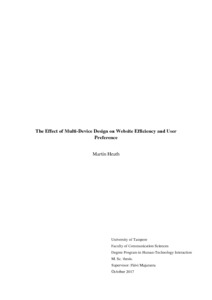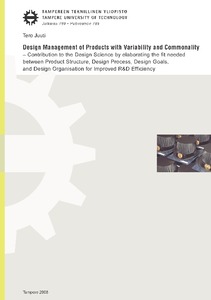The effect of multi-device design on website efficiency and user preference
Heath, Martin (2017)
Heath, Martin
2017
Tietojenkäsittelytieteiden tutkinto-ohjelma - Degree Programme in Computer Sciences
Viestintätieteiden tiedekunta - Faculty of Communication Sciences
This publication is copyrighted. You may download, display and print it for Your own personal use. Commercial use is prohibited.
Hyväksymispäivämäärä
2017-11-15
Julkaisun pysyvä osoite on
https://urn.fi/URN:NBN:fi:uta-201711292830
https://urn.fi/URN:NBN:fi:uta-201711292830
Tiivistelmä
Modern websites must accommodate many different devices with varying screen size without decreasing user experience or losing relevant features or content. In this thesis, three different multi-device design approaches, adaptive, responsive and mobile-dedicated, were researched on desktop, tablet and smartphone devices to ascertain whether one approach is superior to the others in terms of user preference and website simplicity and efficiency. A total of eight mock websites were created to represent the approaches on each device.
The mock websites were first evaluated with an expert analysis, wherein the indi-vidual page load times and aesthetic values of the sites were calculated. Then, a user study was performed, where 10 participants performed search tasks on each mock website, evaluating each site after completing the tasks. Additionally, a semi-structured interview was conducted after each study session and eye tracking data was collected during the study to identify possible differences in gaze behavior between the mock sites.
The results showed that no single approach was superior, as the results were very similar. However, it was discovered that participants disliked the mobile layout on the desktop device, even though it produced the highest efficiency. The results additionally suggested that mobile devices are preferred for their ease of use and accessibility, in-stead of for the layout design. Finally, a behavior where participants let their eyes rest while using the device to browse through a site was observed. Further study is suggested for the behavior, dubbed restful browsing, as it could have a strong influence on mobile web use.
The mock websites were first evaluated with an expert analysis, wherein the indi-vidual page load times and aesthetic values of the sites were calculated. Then, a user study was performed, where 10 participants performed search tasks on each mock website, evaluating each site after completing the tasks. Additionally, a semi-structured interview was conducted after each study session and eye tracking data was collected during the study to identify possible differences in gaze behavior between the mock sites.
The results showed that no single approach was superior, as the results were very similar. However, it was discovered that participants disliked the mobile layout on the desktop device, even though it produced the highest efficiency. The results additionally suggested that mobile devices are preferred for their ease of use and accessibility, in-stead of for the layout design. Finally, a behavior where participants let their eyes rest while using the device to browse through a site was observed. Further study is suggested for the behavior, dubbed restful browsing, as it could have a strong influence on mobile web use.
Kokoelmat
Samankaltainen aineisto
Näytetään aineisto, joilla on samankaltaisia nimekkeitä, tekijöitä tai asiasanoja.
-
Design Management of Products with Variability and Commonality - Contribution to the Design Science by elaborating the fit needed between Product Structure, Design Process, Design Goals, and Design Organisation for Improved R&D Efficiency
Juuti, Tero
Tampere University of Technology. Publication : 789 (Tampere University of Technology, 2008)
MonografiaväitöskirjaThe research objective is to find solutions for how companies manufacturing physical products are able to increase profitability and efficiency with products using variability and commonality. The focus of this research ... -
User Experience Design and Evaluation of Persuasive Social Robot As Language Tutor At University : Design And Learning Experiences From Design Research
Gnanasekar, Tamilselvi (2023)
Pro gradu -tutkielmaHuman Robot Interaction (HRI) is a developing field where research and innovation are progressing. One domain where Human Robot Interaction has focused is in the educational sector. Various research has been conducted in ... -
Constructing a design framework and design methodology from educational design research on real-world educational technology development
Lehtonen, Daranee (2021)
articleEducational design research (EDR) seeks to contribute to both practice and theory by developing solutions that improve educational practice and generating usable and generalisable knowledge. Most EDR researchers tend to ...



